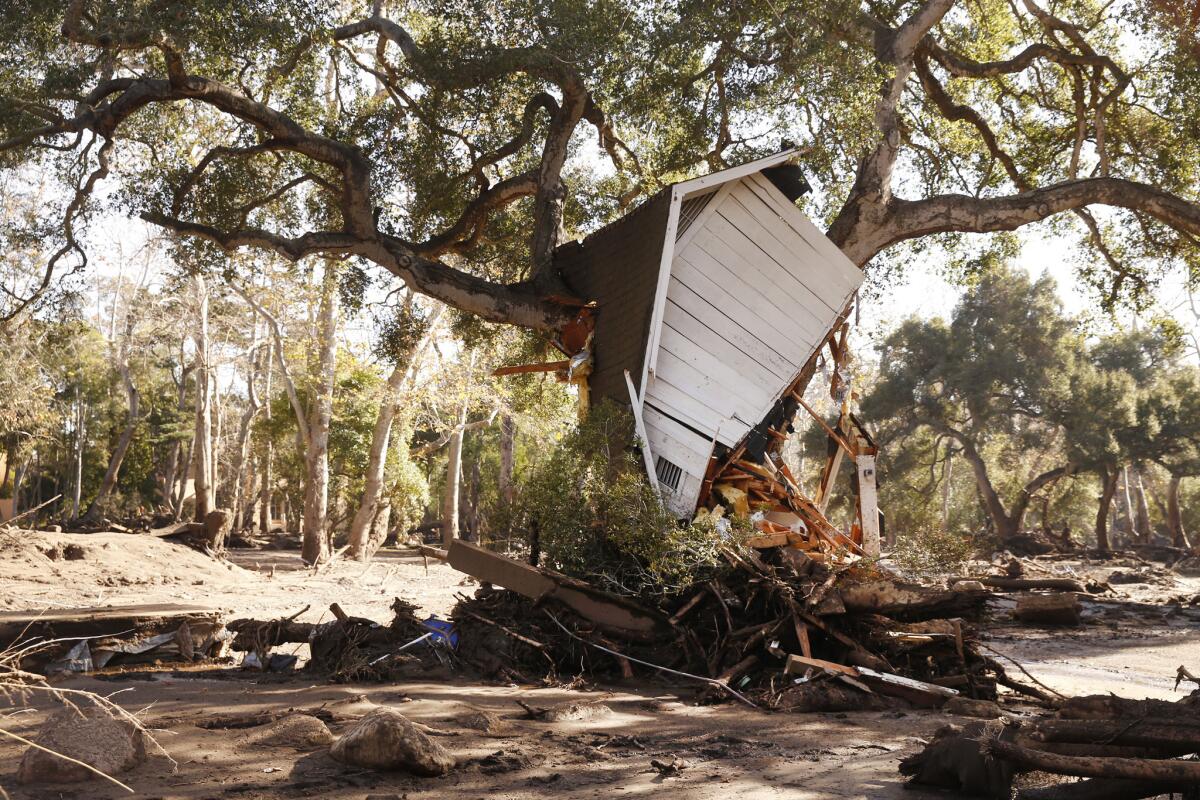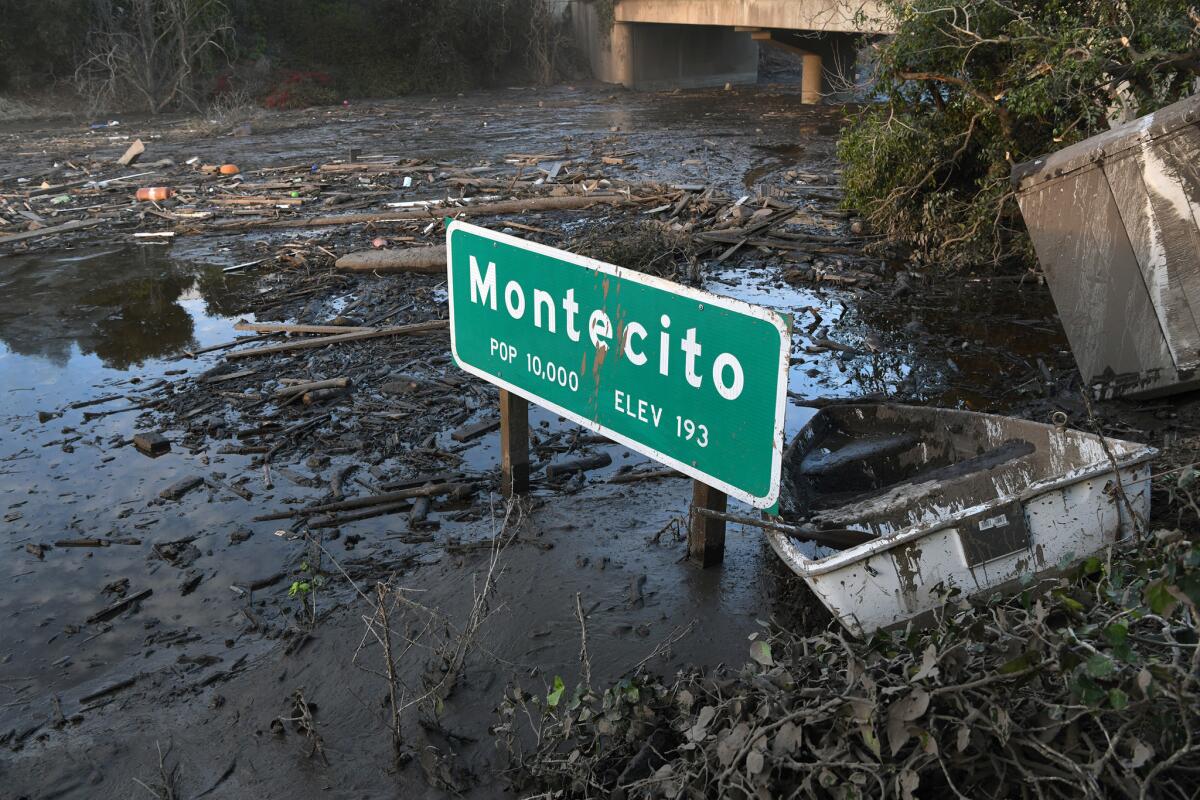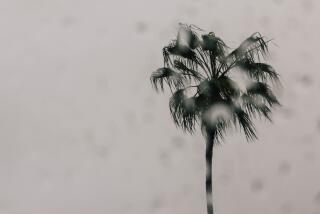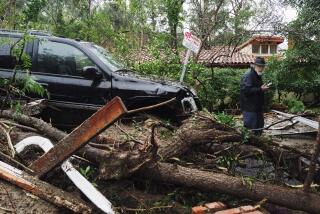Threat of mudslides returns to California after devastating fires. How do they work?

A Thanksgiving Day storm hit Southern California, bringing heavy rain that could result in mudflows in recent wildfire burn areas.
The National Weather Service issued a flood advisory for Southern California for Thursday morning, saying intense downpours of up to a half-inch an hour could cause mudflows in burn areas, including around the Getty Fire area in Brentwood and the Palisades fire in Pacific Palisades.
Why do mudslides happen so often in California?
Mudslides have always been at the heart of the peril of living close to the mountains in California. All it can take is an intense amount of rain in a short amount of time to create damaging flows of mud and debris that can kill people and destroy buildings.
Mudslides are a particular risk for people living close to mountains. California’s mountains are quite tall, and the elevation drops extremely rapidly as water drains to the sea. The situation has become more dangerous as humans came to inhabit these paths of destruction.
“There’s a competition between the growth of the mountains and the erosion from the rainstorms,” U.S. Geological Survey hydrologist Jason Kean said. “They’re in this constant battle.”

Animated infographic shows how debris flows and deep-seated landslides happen
How do wildfires worsen the mudslide risk?
When hills are verdant and healthy, vegetation can anchor the soil in place, even during heavy storms. But when the protective blanket of vegetation is burned off, hillsides become vulnerable to erosion, and slopes can come crashing down in a torrent of mud, rocks and dead branches like white-water rapids, destroying homes.
The heat from the fire makes it harder for water to infiltrate the top soil layer, Kean said. Ash tends to clog the soil after fire, and oily substances can affect the ground’s ability to absorb water. Impact from the rain can also help seal the top layer of sediment.
As a result, the soils become repellent to water. Instead of percolating below the surface, water starts flowing on the surface downhill and begins to pick up rock and debris, Kean said.
It’s like water on a parking lot or the surface of a playground slide, Kean said: “When the rainfall hits it, it just runs right off. … The rapid runoff from these bare hill slopes can quickly pick up sediment, and that can transform into a really nasty debris flow.”

What are some different varieties of mudslides?
Good question. Here’s what some experts use:
Mudflow: Water rushing down with only mud. This is considered a type of shallow landslide — less than 15 feet deep.
Debris flow: When water rapidly flows downhill and, besides mud, picks up rocks, branches and sometimes massive boulders. This is also considered a type of shallow landslide.
Can mudslides happen after the rain stops?
Yes. A shallow landslide involves a saturated hillside that collapses but does not move very far, such as one that buries a roadway with dirt and rocks from a neighboring slope. They can happen up to an hour after a burst of intense rain.
How deadly can mudslides be?
Moments after New Year’s Day began in 1934, a major flood and mudslide came sailing down the La Crescenta Valley, triggered by heavy rains preceded by a fire in the nearby Angeles National Forest. A 20-foot wall of mud and rocks came thundering out of canyons, killing 45 people and destroying more than 400 homes, according to Los Angeles County archives.

In January 2018, 23 people died and at least 130 homes were destroyed when a river of mud and rock flowed through coastal Montecito, which had been burned less than a month earlier in the Thomas fire. That fire, one of California’s most destructive on record, burned 282,000 acres in Ventura and Santa Barbara counties.
Why was the death toll in the Montecito mudslide so high?
There was a considerable amount of evacuation fatigue in the Montecito area from earlier storms that rolled through but did not cause major debris flow, and many residents declined to evacuate.
Fueling the death toll was a once-in-500-year storm cell that dumped more than a half-inch of rain in five minutes in the middle of the night, dissolving the hills into a river of mud and rock. Though the downpour slowed, it did not immediately stop and the mudflow quickly filled up basins.
A Times investigation found that government officials did not heed decades-old warnings to build bigger basins that could have made the mudslides far less catastrophic — and that Santa Barbara County failed to thoroughly empty the existing basins before the disaster, drastically reducing their capacity to trap debris.
Local authorities also did not order mandatory evacuations to cover all the areas where fatalities occurred in the days before the deadly debris flow. Some of those who died lived in mandatory evacuation zones and declined to evacuate, but the majority of the dead were in voluntary evacuation zones.
Boulders and mud flowed all the way to U.S. 101 and then the ocean.
Have clogged drainage basins been in a problem in other debris flows?
Yes. In 2010, the winter after the largest fire in L.A. County history, a debris flow — which one resident described as a “Niagara Falls” — went down La Cañada Flintridge’s northernmost neighborhood when a 10-ton boulder clogged a critical basin, plugging up the drain like a giant stopper. More than 40 homes were damaged.
It came as a surprise because the storm was supposed to have been fast moving but unexpectedly stalled and dumped rain at an alarming rate. The forecast authorities had relied on in the days leading up to the three-day storm had called for a light to moderate rain. No evacuations had been ordered.
How long does it take for hillsides to recover from wildfires?
Generally, burn areas are more prone to debris flow for three to five years after a fire — the amount of time usually needed for vegetation to grow back. With each additional year of recovery, the risk decreases, experts said.
How much rainfall is needed to trigger mud or debris flows?
For burned areas, mud and debris flows can strike with only intense rainfall, even if the ground is not saturated.
What can burned communities do to prepare?
In the winter of 2015, the Ventura County community of Camarillo Springs prepared with detailed evacuation plans mapped out; officials cleaned out debris basins and installed steel cable netting designed to catch large rocks at the base of the slopes.

What are the areas authorities are worried about in the winter of 2019-20?
All areas that burned this year would be of concern, Kean said, but especially of note are areas burned by the Kincade fire in Sonoma County, the Tick fire of Santa Clarita and the Getty fire on the Westside of Los Angeles. The Cave fire burning north of Santa Barbara is also a concern.
What’s the least predictable type of landslide?
The kind that can strike on a dry day.
In areas where the bedrock is very deep, rainwater can seep deep underground during multiple rainstorms. During a series of repeated heavy storms, water can eventually start to accumulate and build up pressure, Kean said.
The pressure can destabilize an entire chunk of land, causing it to collapse downhill. The landslide can happen slowly and show warning signs such as cracking or subtle movement, allowing people time to escape. But they can also strike rapidly with no warning, even on a rainless day months after the end of winter.
This is called a deep-seated landslide, involving landslides greater than 15 feet deep. Often, deep-seated landslides strike in areas with a history of such events. The USGS has warned that such landslides can become active many months after a very wet winter.
What’s an example of a deep-seated landslide?
An example of where a deep-seated landslide has occurred is Bluebird Canyon of Laguna Beach.
One occurred on a foggy morning in June 2005 after heavy rains fell over the previous December through February. No rainfall occurred during or just before the landslide. Seventeen homes were destroyed and 11 seriously damaged.
There has been a history of devastating landslides in Bluebird Canyon. The neighborhood suffered a slide in October 1978 that destroyed more than 20 homes. The California Division of Mines and Geology said the heavy rains between December 1977 through April 1978 are believed to have played a role, along with a history of landslides and erosion at the site, and weakness in the rock.
Deep-seated landslides have also hit the Ventura County hamlet of La Conchita twice in recent decades, in 1995 and 2005. The second landslide occurred at the end of an intense 15-day rainy period that saw heavy precipitation throughout Southern California. It came with no warning and buried 10 people, killing them.
What about cliffs that fall into the sea?
California has in the past seen cliffs erode into the sea in places like Encinitas in San Diego County and Pacifica, about a 15-mile drive south of San Francisco.
Pacifica’s cliffs are composed of some of the weakest soils along the California coast, USGS research civil engineer Brian Collins said.
The cliffs are being attacked from both the bottom and on top from water. At its base, the ocean is eroding the cliffs. When heavy rains come from above, water seeps into the soil and eventually exits when it reaches less permeable layers.
The nature of this seepage weakens the bonds in the soil that keep the soil particles together, “so it collapses,” Collins said.
The coast in this region has been eroding for thousands of years. As sea levels have risen, the ocean has eroded the cliffs. And the San Andreas fault has been lifting the cliffs up, only for them to be taken down by the seas and the rain.
Times staff writer Raoul Rañoa contributed to this report.
More to Read
Start your day right
Sign up for Essential California for news, features and recommendations from the L.A. Times and beyond in your inbox six days a week.
You may occasionally receive promotional content from the Los Angeles Times.









